If you have leftover bread pudding or are wondering if you can bake the dessert in advance, freezing bread pudding is the solution you’re looking for.
Bread pudding freezes well, and the whole process is super simple. All you need is a few freezer bags and perhaps some plastic wrap or aluminum foil.
There’s no special way you need to bake the dessert to freeze it, so you can freeze homemade bread pudding just as well as a store-bought one. And you can freeze it whole or sliced, depending on your needs.
Now, not everyone agrees that bread pudding freezes well, but most recipe bloggers do, and I was happy about the results I got too.
Interested in freezing bread pudding, defrost it, and then reheating?
Let’s get into it.
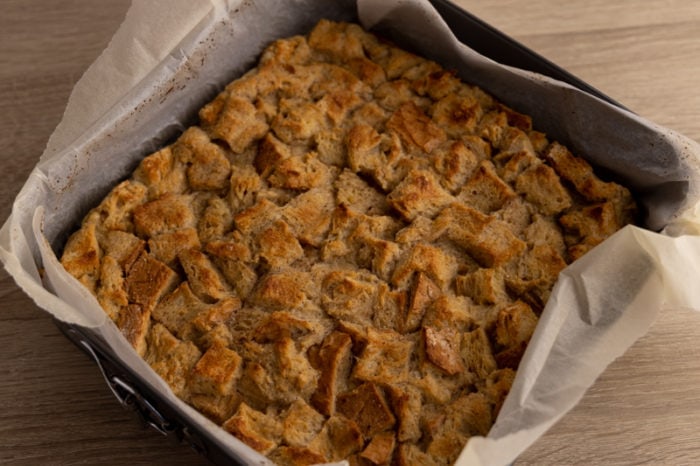
How Freezing Affects Bread Pudding?
There will be a bit of frost on the surface and the bottom of frozen bread pudding. There’s no way around it.
The dessert is loaded with wet ingredients like eggs and milk (or cream), and some of that moisture will get to the surface and freeze.
Here’s how it might look like:
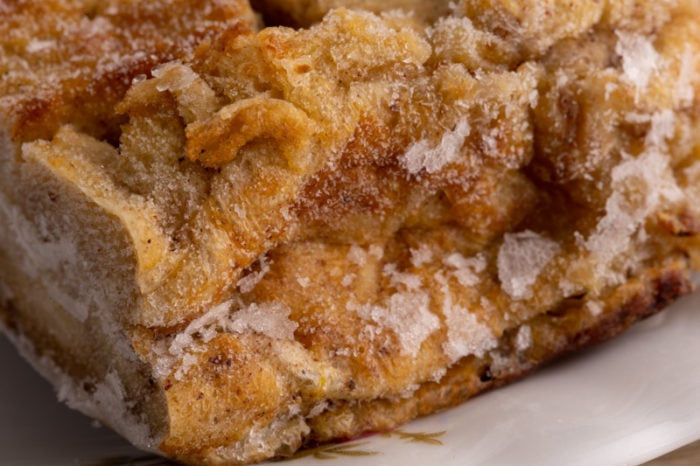
Of course, the moister the pudding, the more frost there will be.
And once you defrost the dessert, it might turn out a bit soggy (hey, there’s a lot of water in it). Fortunately, there are ways to minimize that effect that I talk about in the how-to section.
Plus, reheating the cake before serving it resolves most of those issues. And since most people prefer bread pudding warm anyway, that’s not that much to ask.
Overall, freezing bread pudding comes with its downsides, and it definitely doesn’t freeze as well as cheesecake does, but with a bit of effort (reheating), it freezes pretty well.
If a whole baking dish of bread pudding is too much for you (bread pudding keeps for only 4 to 5 days in the fridge), freezing is the way to go. You cut out how much you need for the next couple of days and freeze the rest.
How To Freeze Bread Pudding
Here’s how you freeze bread pudding:
- Prep. If it’s a homemade bread pudding, let it cool to room temperature. About an hour should be enough. Next, if it’s super moist (there are tiny drops of water on the bottom), get rid of some of that moisture by leaving the dessert on a couple of paper towels for half an hour. Last, cut the pudding into slices or portions if need be.
- Wrap. Place each portion into a freezer bag, or wrap it with plastic wrap and then place in a bag. The more time you expect it to sit in the freezer, the more important wrapping is. I discuss that in more detail below. If you’re freezing individual slices, each one needs to be wrapped separately. Otherwise, they’re going to freeze together because the dessert is super wet.
- Freeze. Add some labels to your bags if you like, and put everything in the freezer.
That’s it. The process doesn’t involve much work, but it takes a while before you can place a just-baked bread pudding in the freezer.
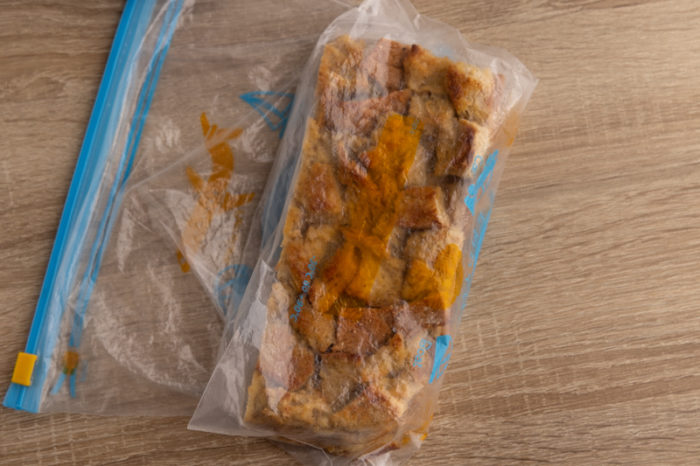
Avoiding Freezer Burn
When you’re freezing virtually any food, you want to avoid freezer burn. You do that by carefully wrapping the product and using more than one layer if freezing for a prolonged period.
Bread pudding is no different.
My recommendation is that if you freeze bread pudding for a short period, like up to a month, simply placing the portions or slices in freezer bags is good enough. Just make sure you squeeze out as much air as you can before sealing them, and you’re going to be fine.
If, however, you know that the dessert might sit in the freezer for longer than that, double wrapping is worth considering. Wrapping each slice using plastic wrap or aluminum foil takes some time, but it helps preserve the quality of your bread pudding for longer.
Feel free to skip double-wrapping if you don’t mind the quality being a bit worse (but still pretty good). I rarely do it (I’m lazy, plus I’m trying to cut back on plastic).
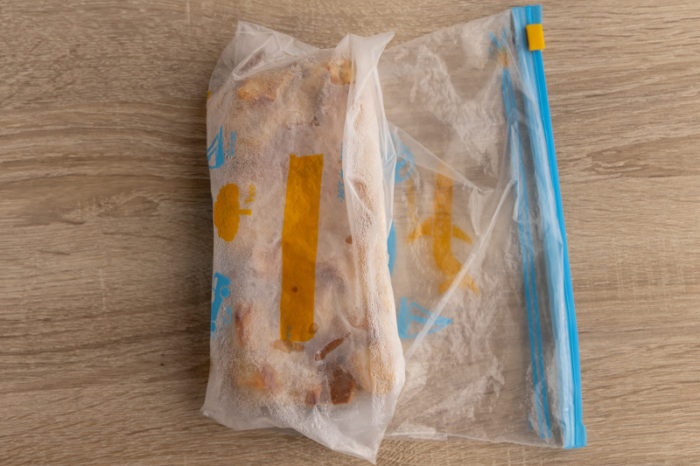
Toppings
If you like your bread pudding with some topping or sauce, consider how well it freezes. If it doesn’t freeze well, you should postpone topping the dessert until it’s ready for serving.
But if it freezes just fine, there’s another issue: reheating.
Before you top your bread pudding with your favorite sauce, consider how reheating the dessert will affect it. For example, whipped cream freezes okay, but you definitely don’t want to heat it in the oven or microwave.
In short, in most cases, it’s best to freeze bread pudding without the topping and add it only after reheating the dessert.
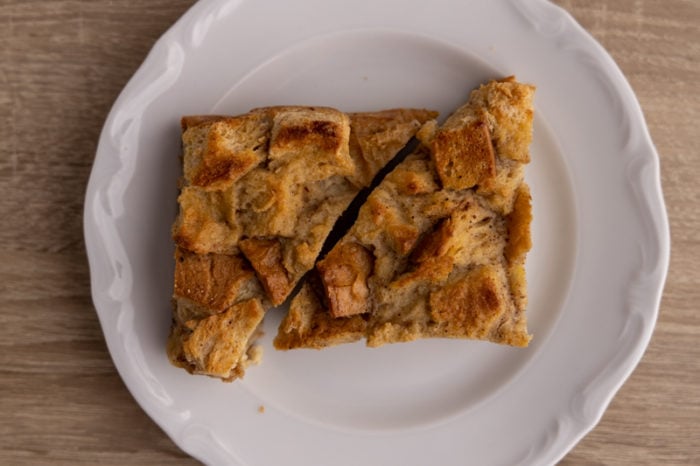
How Long Can Bread Pudding Be Frozen?
Use your frozen bread pudding within three months for best quality.
Of course, that period is only a rough suggestion, and the sooner you get to the dessert, the better.
But if it sits in the freezer for 4 or 6 months, nothing that bad will happen. Its quality might be a bit worse, but that’s about it. It’s a dessert; it’s still going to taste good.
The main thing is that you don’t forget about it so that it doesn’t end up sitting in the freezer for a year or more. That’s why I try to use most of the foods that I freeze within a month of freezing, while I still remember about them.
How To Defrost Bread Pudding
Defrost bread pudding in the refrigerator. The whole process takes 6 to 8 hours, so it’s best to transfer the dessert into the fridge the night before you need it.
Bread pudding defrosts slowly since there’s a lot of liquid in the cake, and it really needs those 6 to 8 hours or overnight.
If there’s a lot of frost on the bottom, consider placing a couple of paper towels under the pudding so that they soak up some of the extra moisture. The goal here is that the bottom doesn’t end up completely soggy.
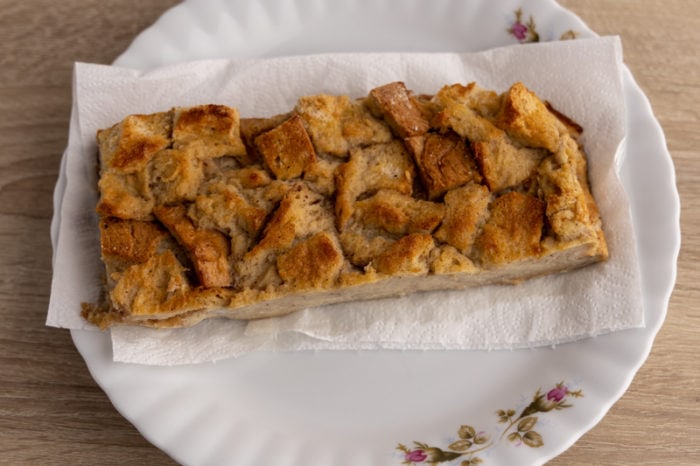
Try sticking a knife or a skewer in the middle to check if your bread pudding is fully thawed. If it goes all the way to the bottom, the dessert is good to go.
Now, defrosted bread pudding is okay to eat, but its flavor can be so much better if you reheat it. Let’s talk about that in more detail.
Reheating Bread Pudding
To get the best quality out of your frozen and defrosted bread pudding, you need to reheat it. Most people prefer warm bread pudding anyway, so you’d probably do that even if the dessert sat in the fridge.
The two most popular reheating options include:
- in the oven, which is great for warming up larger portions
- in the microwave, which works well if you’re short on time or you’re reheating individual slices
Here’s how to go about both of those methods.
In the Oven
Here’s how to reheat bread pudding in the oven:
- Preheat the oven to 350°F (180°C).
- Wrap the dessert in aluminum foil. You do that so that it doesn’t dry out in the oven.
- Heat for 12 to 15 minutes, depending on portion size. For a whole bread pudding, you might need a bit more, like 18 minutes or so.
If you’d like a crispy top, take the foil off for the last 3 to 4 minutes. It’s a simple solution, but it works beautifully.
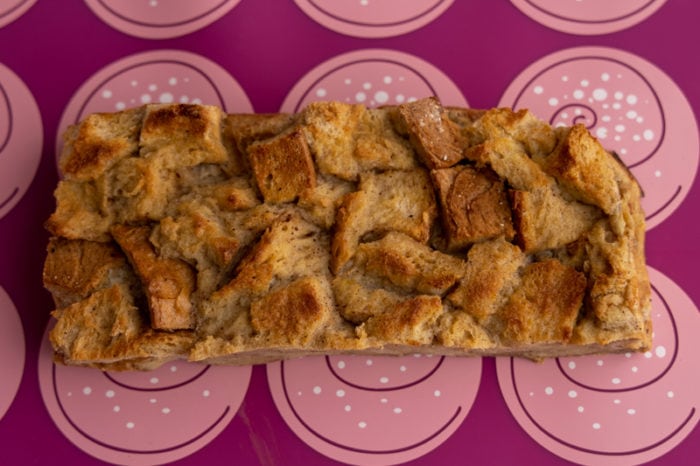
In the Microwave
Here’s how you reheat bread pudding in the microwave:
- Place the slice or portion on a microwave-safe plate.
- Blast the bread pudding on full power in 20 to 30-second increments. Check how the dessert is doing after every nuke.
If your bread pudding isn’t a particularly moist one, or you notice that it’s becoming dry, switch from 100% power to 50% power, and double the microwaving time. Lower power helps reheat the dessert more evenly, and doesn’t dry out the surface and sides so fast.
Alternatively, find a microwave-safe resealable dish (like an inverted bowl or something similar) that you can place the bread pudding slice in. It will help keep most of the moisture in the dessert instead of letting all of that stem out. It’ll also help reheat the cake more evenly.
If you want that crispy top and your microwave has a broiler, put the broiling rack and the broiler setting to use.
Now that your bread pudding is reheated, all else I can say is bon appétit.